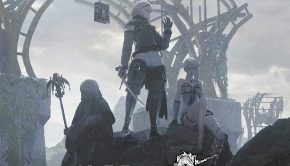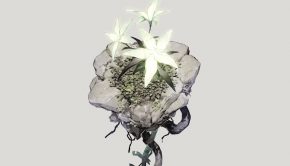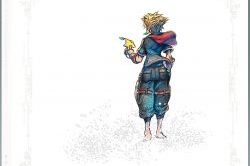Nier Gestalt & Nier Replicant Original Soundtrack
 |
Album Title: Nier Gestalt & Nier Replicant Original Soundtrack |
| Record Label: Square Enix |
|
| Catalog No.: SQEX-10189/90 |
|
| Release Date: April 21, 2010 |
|
| Purchase: Buy Used Copy |
Overview
Nier Gestalt and Nier Replicant are two action RPGs developed by Cavia and published by Square Enix. Although the scenarios are different, the music between them is shared. Cavia’s previous published works featured music by Takayuki Aihara and Nobuyoshi Sano (Drakengard) and Yoshiki Aoi (Drakengard 2), and although I wasn’t the biggest fan of the former, I was a big fan of the latter. Upon hearing the initial samples, Yoshiki Aoi was my initial guess as to the compositional team behind this soundtrack. To my surprise, I found out it was being headed by Keiichi Okabe and his team at Monaca. The samples were beautiful and I was willing to give Okabe a shot. Did it pay off?
Body
I can remember a cold day in January when I first heard “Grandma.” Of course, at the time, I didn’t know what it was called, but I can say that the moment I heard it, I fell in love with the entire soundtrack before even hearing the rest of it. Haunting vocal work by Emi Evans combines with equally haunting piano work to craft a theme of extreme sadness. This feeling of sorrow is accentuated through the amazing harmony in the strings work. The final version seems to add some light militaristic percussion to help give it a bit of a rhythmic backing and, although it fits the theme perfectly, even without it, this theme would be amazing.
The opening to the soundtrack, “Snow in Summer,” is an absolutely stunning encapsulation of what follows. As you’ll soon learn, the majority of this soundtrack features prominent use of vocals. In “Snow in Summer,” the melody, superbly crafted, is portrayed in an angelic manor by a boys choir consisting of Daishu Oikawa, Kazuya Miyashita, and Kento Yamazaki. As the theme progresses, some militaristic percussion and some beautiful strings work is added. It helps bring about an extra touch of atmosphere and harmony and really strengthens an already perfect melody. The piece ends with some electronic elements lending its way into the melody as well, giving it a bit of an ethereal nature as well.
The first of many Emi Evans-led themes, “Hills of Radiant Winds” showcases some of the faster tempo themes. This is an exquisitely crafted action-oriented theme that features a gorgeous vocal performance, in conjuction with ethnic percussion, beautiful piano accompaniment, and some fantastic strings harmony. Overall, this is one of those pieces that must bring a smile to my face. It’s clear that the radiance was supposed to be transferred to the listener because it’s such an uplifting composition.
The same melody heard from “Hills of Radiant Winds” is carried over in several other themes. Rather than focus on vocals, although they are present to give the whole piece and ephemeral feeling, “City of Commerce” features a much more ethnic atmosphere, complete with beautiful acoustic guitar and percussion work. It also helps that there is a nice ethereal and atmospheric accompaniment. “The Lost Forest” is an extremely beautiful action-oriented theme that also employs the melody, but it is much more subtle in approach. The instrumental theme features amazing percussion work, however, the true star here, aside from the superb melody, is the acoustic guitar work. It gives the entire piece a Spanish feel. It’s such a great theme. Speaking of instrumentals, “The Prestigious Mask” adds a beautiful Celtic theme to the soundtrack. Mainly instrumental, this theme features some fantastic ethnic percussion, some bell chimes, some ethereal vocal accompaniment, and some woodwinds usage. It’s an extremely touching theme that features a superb blend of instruments.
“The Incomplete Stone,” on the other hand, features the other two additions to the vocal work on the soundtrack, Nami Nakagawa, the female choir section, and Keiichi Okabe, the male choir section. In case you are wondering to yourself, “By Keiichi Okabe, do you mean one of the composers of this soundtrack?,” the answer to that question is “Yes, the same one!” This theme features some great percussion work, which is really one of the driving forces of this theme, and combines it with some haunting choral work by Okabe and Nakagawa. It’s an extremely well-crafted theme and really brings about a fantastic atmosphere. “Cold Steel Coffin” offers the first glimpse into the darker themes on the soundtrack. Featuring both Nakagawa and Okabe, their vocal work really help accentuates the dark elegance that the rest of the instrumentation conveys. For example, the driving percussion and haunting piano lines combine with brass accents and hauntingly beautiful, yet sinister, strings work to create an extremely moving melody. This is truly one of the most impressive themes depicting omen I’ve heard in an extremely long time
Another theme that features Keiichi Okabe’s vocal work is “Blu-bird.” Presumably a battle theme, this composition features a lot of interesting elements. For example, the ominous choral opening by Okabe distorts a bit, giving it a darker tone. Combine that with some fantastic persistent chanting, some fantastic percussion work, and some electronic elements and in the end you are left with an extremely intense theme that features some stunning vocal work. “The Dark Colossus Destroys All” is another one of the presumed battle themes and what a theme it is! Driving percussion, sinister strings work, and epic choral work by Nami Nakagawa are relentlessly thrown at you to form an extremely powerful atmosphere. At times, the choir becomes even more ominous, through the combined use of it and some sharp, staccato strings accents. Overall, this is an extremely powerful and dark theme that is truly one of the pinnacles of the soundtrack.
“The Wretched Automatons” opens up with some industrial rhythm that is soon accompanied by some electronic elements and some dramatic strings work. However, I find the most impressive sections of this theme to be the section where Emi Evans is accompanied solely by the electronic element introduced near the beginning of the theme. Of course, as the theme progresses, percussion heard more traditionally on this soundtrack is introduced that adds a whole new layer of atmosphere to the piece. This is an extremely well-crafted experiment and one that I can’t get enough of.
Upon hearing “Temple of Drifting Sands,” I felt as if I was transported to my own personal Nirvana. This theme, in essence, is an amalgamation of elegance, beauty, and atmosphere. Once again, Emi Evans lends her beautiful voice to craft an extremely moving melody; however, at the same time, her voice is layered to bring with it an extremely ethereal and touching accompaniment. As with the rest of the soundtrack, the percussion really shines in this piece as well, serving as a fitting backbone that supports the extremely powerful weight of the vocal component. In the end, this stunning theme manages to capture my heart. After hearing “Temple of the Drifting Sands,” I can honestly say that its melody is one of my favorites on the entire soundtrack. Fortunately, “Gods Bound by Rules” manages to incorporate this melody into its vocal work. Emi Evans’ vocal work here has an operatic, yet ethereal, flair to it. Of course, this fuses together beautifully with the intense strings and percussion accompaniment and if you listen closely, you can subtly hear Keiichi Okabe’s choral work in the background. In particular, the percussion is extremely powerful and really shines here. It’s another exquisitely crafted theme.
Although the music for “The Ultimate Weapon” might not seem appropriate for the name, the theme is easily one of the most moving themes on the soundtrack. Emi Evans provides some haunting vocal work that is easily the backbone of this piece. If this was an instrumental piece, it wouldn’t nearly be as effective. The atmospheric strings work, the deeply touching, yet slightly ominous, piano line, and the militaristic percussion truly form a cohesive accompaniment that only accentuates the power evoked by Emi Evans’ vocal performance. “Deep Crimson Foe,” on the other hand, is an action-oriented theme that features the melodic motif introduced in “The Ultimate Weapon.” The driving percussion, frenetic strings work, fantastic brass harmonies, and choral work by Nami Nakagawa provide an extremely powerful, yet elegant, theme that moves the listener, albeit in a different way than “The Ultimate Weapon.” The vocal work here truly impresses.
“His Dream,” as one might expect, is an extremely ethereal piece. Instrumental in nature, it features some vocal accents to help create a soothing atmosphere. The true star of this theme, however, is co-composer Keigo Hoashi, who performs some of exquisite, dreamy piano passages. Although the focus on melody isn’t as strong as some of the other themes on the soundtrack, the atmosphere this theme provides more than makes up for that. Similarly, “This Dream” also features an ethereal atmosphere, and although piano is present, the main focus of this theme is the acoustic guitar to create an extremely poignant melody. The vocal accents in this theme also serve to accentuate the dreamy nature this piece conveys. “Repose” is an acoustic guitar led composition that features some exquisite ethereal vocals by Emi Evans. Even though the track title implies a moment of rest, I still sense a feeling of anguish. It’s an extremely beautiful theme and the atmosphere is stunning.
As you’ve witnessed through my review thus far, there are some themes that feature unique melodies and those that feature some melodic motifs. However, there are also other themes on the soundtrack that are essentially arrangements of each other, each bringing with it a different atmosphere. One of the most beautiful repeating themes on the soundtrack belongs to “Song of the Ancients” in all four of its varieties. “Song of the Ancients / Devola” is an exquisite theme that features beautiful rhythm in the form of acoustic guitar and percussion. Overall, it has a very rustic soundscape to it and Emi Evans’ vocal work really accentuates the emotion heard in the acoustic guitar. Out of all the “Songs of the Ancients” this one is easily my favorite.
“Song of the Ancients / Popola,” on the other hand, features the same beautiful vocal melody by Emi Evans, but with an ethereal and atmospheric accompaniment. Rather than a rustic feel, this one obviously has a more dream-like quality to it. “Song of the Ancients / Hollow Dreams,” on the other hand, offers an extremely playful atmosphere through its use of jazzy piano and percussion. The final version, “Song of the Ancients / Fate,” manages to combine elements from each prior version, while at the same time, offering its own identity into the mix. Throughout the theme, you’ll hear some ethereal notes, some playful notes, some rustic notes, as well as the beautiful orchestration offered in this version. I’m sure this is the true vision of the “Song of the Ancients” and even though I enjoy some of the other versions more, this one is equally deserving of attention.
Another theme that was sampled on the website belonged to “Kaine / Salvation.” This is another exquisitely crafted theme featuring Emi Evans. The piano is extremely poignant and the subtle ethereal accompaniment really gives the piece an amazing atmosphere. The vocal melody, as expected, is easily the strongest aspect of this theme. The second version of this theme is “Kaine / Escape.” Although it starts similarly to “Kaine / Salvation,” albeit with a slightly quicker tempo, the majority of the piece features some nice additions, such as some fantastic percussion work, some ethereal accompanying vocals, and some exquisite strings accompaniment and harmony. Another set of themes also relates to a character, Emil. “Emil / Karma” was also featured on the website and is one of the more action-oriented vocal themes on the soundtrack. Rhythmic ethnic percussion and piano are the driving forces behind this piece. Featuring the boys choir heard in “Snow in Summer,” their delicate voices really contrast nicely with the instrumentation. In particular, I really enjoy when the strings are introduced to harmonize with the melody. “Emil / Sacrifice,” on the other hand, is an extremely somber take on the theme and features a strings ensemble in a chamber music format. The strings work is truly exquisite here and accentuates the melody of “Emil” superbly.
The “Dispossession” theme is an extremely touching theme. The melody is absolutely superb and I like the various elements the arrangements bring to it. For example, “Dispossession / Piano Ver.” carries a very romantic tone with a hint of sadness. Of course, this feeling of sorrow is definitely accentuated in “Dispossession / Strings Ver.” Strings are definitely the easiest instrument available to express sorrow and they are truly spectacular in this theme. “Dispossession / Pluck Ver.” is an acoustic guitar arrangement that adds a bit of rustic tones to the somber piece whereas “Dispossession / Music Box Ver.” brings a different atmospheric sadness into the mix. Similarly, the “Yonah” themes are equally beautiful. This theme plays an important role in another set of themes, which I’ll get to later, as it is the same melody, but the same sort of emotions are witnessed throughout the various versions of this theme as well.
The two “Shadowlord’s Castle” themes are quite different in nature. “Shadowlord’s Castle / Memory” features an ethereal atmosphere combined some Keiichi Okabe and Nami Nakagawa’s haunting choral work. It’s a very beautiful piece that relies on the strength of the vocal work while accompaniment is used for atmospheric purposes. It’s absolutely stunning. “Shadowlord’s Castle / Roar,” on the other hand, features the same haunting vocal work, but the accompaniment is more robust. Pounding percussion, brass, and beautiful strings work create an extremely tense atmosphere instilled with a touch of beauty.
Presumably the final boss theme, “Shadowlord” is an absolutely stunning composition featuring Nami Nakagawa and Keiichi Okabe’s stellar choral performances. The first half of the composition is quite haunting, yet at the same time, there is, as I’ve mentioned before, this ominous elegance about it. The organ work coupled with the choral work is just stunning. The second half of the composition features more ominous tones, both in the choral performance as well as the accompanying instrumentation. Riveting percussion and organ work really manage to impress. This is probably my favorite theme on the entire soundtrack. As a bonus, the last song on the album is a remix of this theme that is not used in the game. “Shadowlord – White-note Remix” incorporates some jazzy piano elements. At first glance, it might not sound like it works, but it really does add a whole new twist on the theme. I’m quite the fan.
As I mentioned before, the main vocal theme, “Ashes of Dreams / New,” for the game is essentially a vocal version of “Yonah.” Unlike most vocal themes for games, this one has a brooding atmosphere that combines with some romantic elements, yet never really evolves into something with a bright atmosphere. It’s an extremely somber theme, beautifully crafted lyrics with exquisite piano and strings arrangement, which really strikes at the heart of the listener. There can’t be a happy ending to this game. There are three other versions as well. “Ashes of Dreams / Nouveau” is the version based on the French language of the theme and it progresses a bit different. It takes a good 2 minutes before the vocals are even introduced, but still retains the strings and piano composition. “Ashes of Dreams / Nuadhaich,” is the version based on the Gaelic language and although the lyrics start immediately, the difference in this version is that the piano doesn’t enter into the mix until later. Lastly, “Ashes of Dreams / Aratanaru” is the version based on the Japanese language and its introduction is piano intensive. Although the overall melody is the same, I really enjoyed how each theme progresses slightly different.
Summary
If you are a fan of captivating vocal work, it is your duty to pick up the Nier Gestalt & Replicant Original Soundtrack. Featuring exquisite work by the composers at Monaca and Cavia, this is a soundtrack that doesn’t come around very often. Flawlessly crafted, each theme carries with it its own heart and soul, and even though there are plenty of thematic tie-ins with other themes, they all manage to possess their own unique identity. I, for one, have been in love with this soundtrack ever since I heard the first sample in January. This soundtrack will remain in my collection for many years to come.
Do you agree with the review and score? Let us know in the comments below!
5
Posted on April 20, 2010 by Don Kotowski. Last modified on September 20, 2014.














